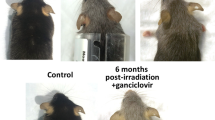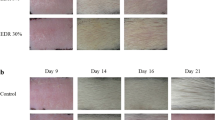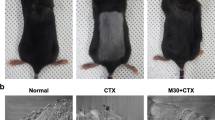Abstract
Alopecia (hair loss) is experienced by thousands of cancer patients every year. Substantial-to-severe alopecia is induced by anthracyclines (e.g., adriamycin), taxanes (e.g., taxol), alkylating compounds (e.g., cyclophosphamide), and the topisomerase inhibitor etoposide, agents that are widely used in the treatment of leukemias and breast, lung, ovarian, and bladder cancers. Currently, no treatment appears to be generally effective in reliably preventing this secondary effect of chemotherapy. We observed in experiments using different rodent models that localized administration of heat or subcutaneous/intradermal injection of geldanamycin or 17-(allylamino)-17-demethoxygeldanamycin induced a stress protein response in hair follicles and effectively prevented alopecia from adriamycin, cyclophosphamide, taxol, and etoposide. Model tumor therapy experiments support the presumption that such localized hair-saving treatment does not negatively affect chemotherapy efficacy.


Similar content being viewed by others
References
Ali A, Bharadwaj S, O’Carroll R, Ovsenek N (1998) HSP90 interacts with and regulates the activity of heat shock factor 1 in Xenopus oocytes. Mol Cell Biol 18:4949–4960
Christodoulou C, Klouvas G, Efstathiou E, Zervakis D, Papazachariou E, Plyta M, Skarlos DV (2002) Effectiveness of the MSC cold cap system in the prevention of chemotherapy-induced alopecia. Oncology 62:97–102
Dorr VJ (1998) A practitioner’s guide to cancer-related alopecia. Semin Oncol 25:562–570
Garrido C, Bruey JM, Fromentin A, Hammann A, Arrigo AP, Solary E (1999) HSP27 inhibits cytochrome c-dependent activation of procaspase-9. FASEB J 13:2061–2070
Gibbons NB, Watson RWG, Coffey RNT, Brady HP, Fitzpatrick JM (2000) Heat-shock proteins inhibit induction of prostate cancer cell apoptosis. Prostate 45:58–65
Hesketh PJ, Batchelor D, Golant M, Lyman GH, Rhodes N, Yardley D (2004) Chemotherapy-induced alopecia: psychosocial impact and therapeutic approaches. Support Care Cancer 12:543–549
Hidalgo M, Rinaldi D, Medina G, Griffin T, Turner J, von Hoff DD (1999) A phase I trial of topical topitriol (calcitriol, 1,25-dihydroxyvitamin D-3) to prevent chemotherapy-induced alopecia. Anti-cancer Drugs 10:393–395
Hoffman RM (2006) The hair follicle and its stem cells as drug delivery targets. Expert Opin Drug Deliv 34:37–443
Huot J, Roy G, Lambert H, Chretien P, Landry J (1991) Increased survival after treatments with anticancer agents of Chinese hamster cells expressing the human Mr 27,000 heat shock protein. Cancer Res 51:5245–5252
Hussein AM, Jimenez JJ, McCall CA, Yunis AA (1990) Protection from chemotherapy-induced alopecia in a rat model. Science 24:91564–1566
Inoue Y, Sato Y, Nishimura M, Seguchi M, Zaitsu Y, Yamada K, Oka Y (1999) Heat-induced drug resistance is associated with increased expression of Bcl-2 in HL60. Anticancer Res 19:3989–3992
Ito H, Shimojo T, Fujisaki H et al (1999) Thermal preconditioning protects rat cardiac muscle cells from doxorubicin-induced apoptosis. Life Sci 64:755–761
Jaattela M, Wissing D, Kokholm K, Kallunki T, Egeblad M (1998) Hsp70 exerts its anti-apoptotic function downstream of caspase-3-like proteases. EMBO J 17:6124–6134
Jimenez JJ, Yunis AA (1988) Treatment with monocyte-derived partially purified GM-CSF but not G-CSF aborts the development of transplanted chloroleukemia in rats. Blood 72:1077–1080
Jimenez JJ, Alvarez E, Bustamante CD, Yunis AA (1995) Pretreatment with 1,25(OH)2D3 protects from Cytoxan-induced alopecia without protecting the leukemic cells from Cytoxan. Am J Med Sci 310:43–47
Jung S, Otberg N, Thiede G, Richter H, Sterry W, Panzner S, Lademann J (2006) Innovative liposomes as a transfollicular drug delivery system: penetration into porcine hair follicles. J Invest Dermatol 126:1728–1732
Kampinga HH (1995) Hyperthermia, thermotolerance and topoisomerase II inhibitors. Br J Cancer 72:333–338
Katsimbri P, Bamias A, Pavlidis N (2000) Prevention of chemotherapy-induced alopecia using an effective scalp cooling system. Eur J Cancer 36:766–771
Kwak HJ, Jun CD, Pae HO et al (1998) The role of inducible 70-kDa heat shock protein in cell cycle control, differentiation, and apoptotic cell death of the human myeloid leukemic HL-60 cells. Cell Immunol 187:1–12
Lavoie JN, Gingras-Breton G, Tanguay RM, Landry J (1993) Induction of Chinese hamster HSP27 gene expression in mouse cells confers resistance to heat shock. HSP27 stabilization of the microfilament organization. J Biol Chem 268:3420–3429
Li L, Hoffman RM (1995) The feasibility of targeted selective gene therapy of the hair follicle. Nat Med 1:705–706
Li GC, Werb Z (1982) Correlation between synthesis of heat shock proteins and development of thermotolerance in Chinese hamster fibroblasts. Proc Natl Acad Sci U S A 79:3218–3122
Liu RY, Li X, Li L, Li GC (1992) Expression of human hsp70 in rat fibroblasts enhances cell survival and facilitates recovery from translational and transcriptional inhibition following heat shock. Cancer Res 52:3667–3673
Moloney WC, Dorr AO, Dowd G, Boschetti AE (1962) Myelogenous leukemia in the rat. Blood 19:45–59
Munstedt K, Manthey N, Sachsse S, Vahrson H (1997) Changes in self-concept and body image during alopecia induced cancer chemotherapy. Support Care Cancer 5:139–143
Oesterreich S, Weng CN, Qiu M, Hilsenbeck SG, Osborne CK, Fuqua SA (1993) The small heat shock protein hsp27 is correlated with growth and drug resistance in human breast cancer cell lines. Cancer Res 53:4443–4448
Parsell DA, Lindquist S (1993) The function of heat-shock proteins in stress tolerance: degradation and reactivation of damaged proteins. Annu Rev Genet 27:437–496
Paus R, Stenn KS, Link RE (1990) Telogen skin contains an inhibitor of hair growth. Br J Dermatol 122:777–784
Paus R, Handjiski B, Eichmueller S, Czarnetzki BM (1994) Chemotherapy-induced alopecia in mice. Induction by cyclophosphamide, inhibition by cyclosporine A, and modulation by dexamethasone. Am J Pathol 144:719–734
Pratt WB, Toft DO (1997) Steroid receptor interactions with heat shock protein and immunophilin chaperones. Endocr Rev 18:306–360
Roigas J, Wallen ES, Loening SA, Moseley PL (1998) Effects of combined treatment of chemotherapeutics and hyperthermia on survival and the regulation of heat shock proteins in Dunning R3327 prostate carcinoma cells. Prostate 34:195–202
Salminen WF, Voellmy R, Roberts SM (1996) Induction of hsp 70 in HepG2 cells in response to hepatotoxicants. Toxicol Appl Pharmacol 141:117–123
Samali A, Cotter TG (1996) Heat shock proteins increase resistance to apoptosis. Exp Cell Res 223:163–170
Schilli MB, Paus R, Menrad A (1998) Reduction of intrafollicular apoptosis in chemotherapy-induced alopecia by topical calcitriol-analogs. J Invest Dermatol 111:598–604
Vilaboa NE, Galan A, Troyano A, de Blas E, Aller P (2000) Regulation of multidrug resistance 1 (MDR1)/P-glycoprotein gene expression and activity by heat-shock transcription factor 1 (HSF1). J Biol Chem 275:24970–24976
Wang J, Lu Z, Au JLS (2006) Protection against chemotherapy-induced alopecia. Pharm Res 23:2505–2514
Whitesell L, Mimnaugh EG, de Costa B, Myers CE, Neckers LM (1994) Inhibition of heat shock protein HSP90-pp60v-src heteroprotein complex formation by benzoquinone ansamycins: essential role for stress proteins in oncogenic transformation. Proc Natl Acad Sci U S A 91:8324–8328
Xia W, Vilaboa N, Martin JL, Mestril R, Guo Y, Voellmy R (1999) Modulation of tolerance by mutant heat shock transcription factors. Cell Stress Chaperones 4:8–18
Yunis AA, Arimura GK, Haines HG, Ratzan RJ, Gross MA (1975) Characteristics of rat carcinoma in culture. Cancer Res 35:337–345
Zou J, Guo Y, Guettouche T, Smith DF, Voellmy R (1998) Repression of heat shock transcription factor HSF1 activation by HSP90 (HSP90 complex) that forms a stress-sensitive complex with HSF1. Cell 94:471–480
Acknowledgments
We thank M. Fenna, J. He, J. Xie, and S.L. Hsia for their help with certain experiments, and Walter Scott and David Barber for the critical review of the manuscript. This study was supported in part by the Rockefeller Brothers Fund (02-237), NCI grant R01 CA093489, and HSF Pharmaceuticals S.A.
Author information
Authors and Affiliations
Corresponding author
Rights and permissions
About this article
Cite this article
Jimenez, J.J., Roberts, S.M., Mejia, J. et al. Prevention of chemotherapy-induced alopecia in rodent models. Cell Stress and Chaperones 13, 31–38 (2008). https://doi.org/10.1007/s12192-007-0005-1
Received:
Revised:
Accepted:
Published:
Issue Date:
DOI: https://doi.org/10.1007/s12192-007-0005-1




